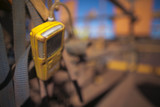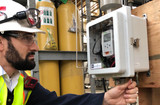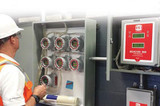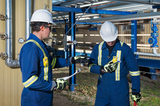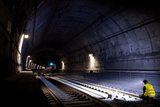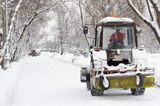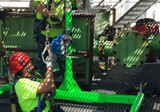Blog
Purge Test: Gas Detection & Purge Testing
When taking a gas pipeline offline or installing a new one, utility crews must first treat the confined space with inert gas, such as nitrogen, to limit the chances of combustion. After the pipeline has been treated, workers should test the space for the presence of hazardous gases. This is what’s known as purge testing. However, this is not the same as conventional gas detection. The pipeline will contain little oxygen and high concentrations of natural gas, which could damage the gas detect
…
Sep 8th 2020
Frequently Asked Questions about LEL Gas and LEL Gas Detectors
Understanding the lower explosive limits (LEL) of combustible gases is crucial when it comes to protecting the health and safety of your employees. As a construction worker, maintenance professional or someone that works in confined spaces, you need to be aware of the LELs of certain hazardous gases, while measuring the amount of gas in the air as a percentage of the total volume using a gas monitor. If the amount of gas in the air suprasses the LEL, the gas could spontaneously combust, injur
…
Apr 6th 2020
New FR Cargo Pants and Color Selections by GRIT, PK Safety’s Exclusive Line of FR Workwear
There’s nothing like feeling safe and comfortable at work. That’s why we’re excited to announce the release our new GRIT Flame Retardant (FR) cargo pants new color selections. GRIT is PK Safety’s exclusive line of FR clothing for hardworking professionals. All GRIT products are UL (Underwriters Laboratories) classified, which means they’ve been thoroughly inspected and approved by a licensed safety professional.
With over 70 years in the business, we know what workers want whe
…
Mar 9th 2020
When and How to Install an RKI Beacon Fixed Gas Detection Systems
When it comes to monitoring and detecting hazardous gases like carbon monoxide, chlorine, nitrogen dioxide, and phosgene (for example), there are two kinds of monitors: portable gas monitors and fixed system gas monitors. The user will wear a portable gas monitor on their lapel, or near what’s known as the breathing zone when working in potentially hazardous environments. Another choice would be a 'Fixed Point' gas detector. As the name implies, the sensor is typically mounted in place, and d
…
Dec 9th 2019
New CleanSpace Respirators Kits
Between
the lack of fresh air and the potential for hazardous gases and particulates,
working in high-dust sites offer a unique set of safety challenges.
Worker safety has always been a top priority at PK Safety, and we’re now
offering more options for confined space workers that need to breathe clean
air. We carry a range of CleanSpace Respirators products and accessories, but we have two new respirator kits to consider
when it comes to replacing or upgrading your current air quality s
…
Jan 31st 2019
Knowing the Difference Between Gas Detectors and Gas Monitors
Commercial spaces can
have a number of confined spaces as well as toxic or combustible atmospheres
that make the environment dangerous for workers. Avoiding accidents, especially
in manufacturing, comes down to having a reliable system for monitoring and detecting
gases. Most gases are clear, odorless, and undetectable to human senses, so the
right tools are necessary to identify problems before they become dangerous.
There’s a lot of gas detection and monitoring products out there, so
…
Dec 3rd 2018
PK Safety Black Friday Sale
It’s the season for savings, and we at PK Safety think that saving money on workplace safety equipment that saves lives is a great idea. For a limited time, we’re having sales on confined space safety equipment, including BW Clip 2 year single gas detectors. Here’s some of the equipment you can save money during Black Friday week with PK Safety.
Single Gas Detectors
Single use gas detectors are a convenient option for ensuring that you can detect important gases reliably in a variety
…
Nov 16th 2018
Winter Protection for Confined Spaces
COLD WEATHER DANGERS
A winterized workplace safety culture
will be aware of the season’s unique safety hazards. Any workplace that has
slip, trip, and fall hazards, falling object hazards, or fire hazards in normal
weather conditions will still have those hazards when the weather gets colder.
A danger unique to cold, wet, and windy conditions are cold stress hazards,
which can take the form of trench foot, frostbite, and hypothermia. These
conditions can set in when the body temperatur
…
Nov 6th 2018
The Best Davit Systems for Use in Confined Spaces
A davit is a popular crane-like device made of steel or aluminum and designed for supporting, raising, lateral moving, and lowering people, working platforms, boats, anchors, or other heavy equipment. Davit systems can be used to lower a lifeboat to the embarkation level for boarding. They can be utilized as man-overboard safety devices to retrieve people from the water. You can also see people using davits when they are working on buildings with various terrace levels.
…
Jul 7th 2017
Confined Space Entry — Top 3 Safety Tips
When working in confined spaces, it’s critical that workers stay safe from hidden and potentially deadly dangers. These spaces - which, according to the U.S. Department of Labor’s Occupational Health and Safety Administration, are usually small and difficult to exit - can include places like coal mines, manholes, grain elevators or wine tanks, along with many others. OSHA recognized this and created more confined space regulations in 2015.Why is OSHA Focusing on Confined Spaces?The danger of the
…
Mar 16th 2017


